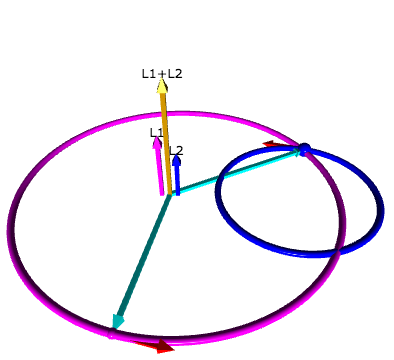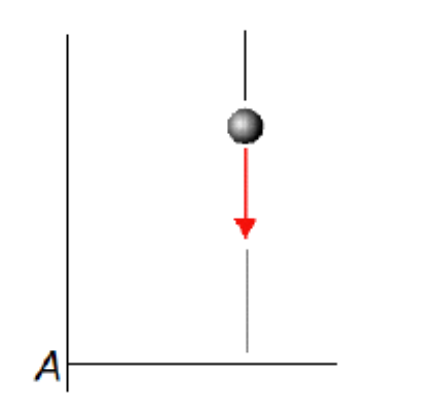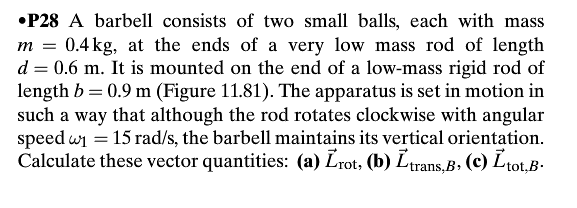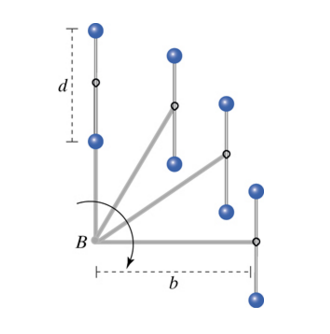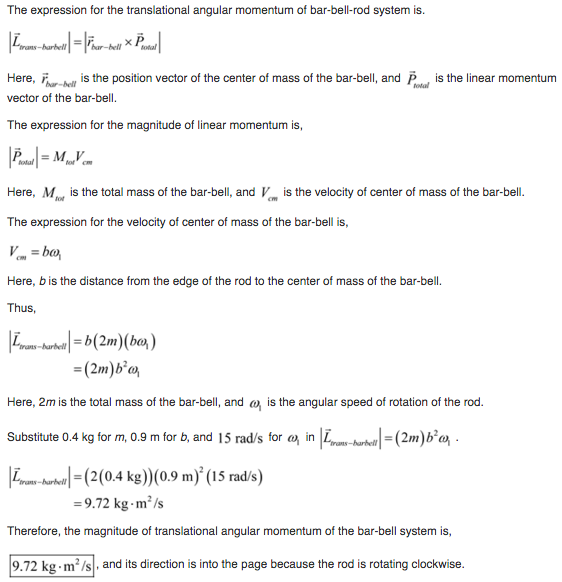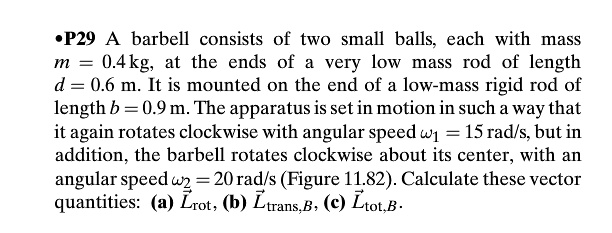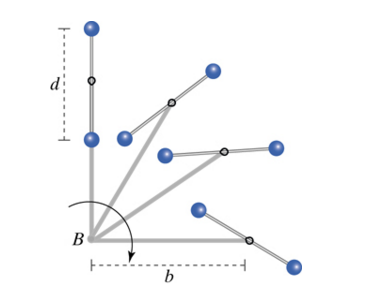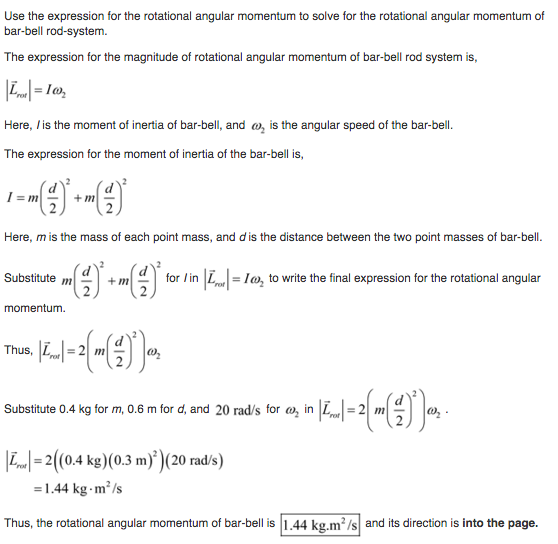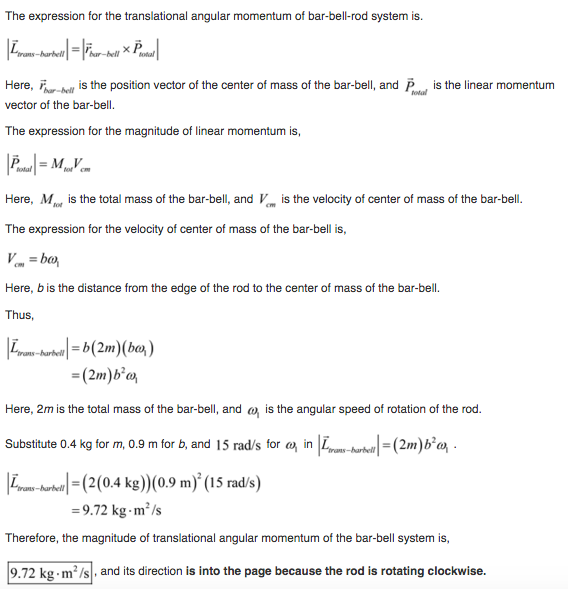Total Angular Momentum: Difference between revisions
Fatimajamil (talk | contribs) |
No edit summary |
||
| Line 1: | Line 1: | ||
Work in Progress by Fatima Jamil | Work in Progress by Fatima Jamil | ||
Total angular momentum can be expressed as [[File:Total Angular Momentum.png]] | Total angular momentum is a measure of rotational motion. It can be expressed as the sum of rotational and translational angular momentum, and is [[File:Total Angular Momentum.png]] This page explains the breakdown of total angular momentum in these 2 components to help understand the difference between rotational angular momentum and translational angular momentum. | ||
==The Main Idea== | ==The Main Idea== | ||
| Line 7: | Line 7: | ||
[[File:Translational and Rotational Angular Momentum.png]] | [[File:Translational and Rotational Angular Momentum.png]] | ||
It is conveniant to break apart total angular momentum for a multiparticle system into rotational angular momentum and translational angular momentum. The translational angular momentum is associated with a rotation of the center of mass about some point A. This differs for different choices of the location of point A. The rotational angular momentum is associated with a rotation about the center of mass. The rotational angular momentum is independent of the location of the point A and the motion of the center of mass. | It is conveniant to break apart total angular momentum for a multiparticle system into rotational angular momentum and translational angular momentum. The translational angular momentum is associated with a rotation of the center of mass about some point A. This is comparable to the earth rotating around the sun. This differs for different choices of the location of point A. The rotational angular momentum is associated with a rotation about the center of mass. This is comparable to the earth rotating on its own access, because the location of the center of mass of the earth remains the same. The rotational angular momentum is independent of the location of the point A and the motion of the center of mass. | ||
===A Mathematical Model=== | ===A Mathematical Model=== | ||
| Line 102: | Line 102: | ||
==Connectedness== | ==Connectedness== | ||
This topic is connected to my major ( | This topic is connected to my major (biomedical engineering)), because it is important to understand the basics before attempting to solve the bigger picture. In terms of angular momentum, it is important to understand the breakdown of translational and rotational before attempting to solve complex problems involving conservation of angular momentum and more. It can be seen in so many examples, from the rotation of a figure skater to a a yoyo. | ||
Total angular momentum is very interesting to witness in the orbit of planets and satellites. | Total angular momentum is very interesting to witness in the orbit of planets and satellites. | ||
Revision as of 21:55, 18 April 2018
Work in Progress by Fatima Jamil
Total angular momentum is a measure of rotational motion. It can be expressed as the sum of rotational and translational angular momentum, and is ![]() This page explains the breakdown of total angular momentum in these 2 components to help understand the difference between rotational angular momentum and translational angular momentum.
This page explains the breakdown of total angular momentum in these 2 components to help understand the difference between rotational angular momentum and translational angular momentum.
The Main Idea
It is conveniant to break apart total angular momentum for a multiparticle system into rotational angular momentum and translational angular momentum. The translational angular momentum is associated with a rotation of the center of mass about some point A. This is comparable to the earth rotating around the sun. This differs for different choices of the location of point A. The rotational angular momentum is associated with a rotation about the center of mass. This is comparable to the earth rotating on its own access, because the location of the center of mass of the earth remains the same. The rotational angular momentum is independent of the location of the point A and the motion of the center of mass.
A Mathematical Model
It is often convenient to consider the angular momentum of a collection of particles about their center of mass, because this simplifies the mathematics considerably. The angular momentum of a collection of particles is the sum of the angular momenta of each particle:
[math]\displaystyle{ \mathbf{L}=\sum_i \mathbf{R}_i\times m_i \mathbf{V}_i }[/math] where [math]\displaystyle{ R_i }[/math] is the distance of particle i from the reference point, [math]\displaystyle{ m_i }[/math] is its mass, and [math]\displaystyle{ V_i }[/math] is its velocity. The center of mass is defined by:
[math]\displaystyle{ \mathbf{R}=\frac{1}{M}\sum_i m_i \mathbf{R}_i }[/math] where [math]\displaystyle{ M }[/math] is the total mass of all the particles.
If we define [math]\displaystyle{ \mathbf{r}_i }[/math] as the displacement of particle i from the center of mass, and [math]\displaystyle{ \mathbf{v}_i }[/math] as the velocity of particle i with respect to the center of mass, then we have
[math]\displaystyle{ \mathbf{R}_i=\mathbf{R}+\mathbf{r}_i\, }[/math] and [math]\displaystyle{ \mathbf{V}_i=\mathbf{V}+\mathbf{v}_i\, }[/math] In this case, the total angular momentum is:
[math]\displaystyle{ \mathbf{L}=\sum_i (\mathbf{R}+\mathbf{r}_i)\times m_i (\mathbf{V}+\mathbf{v}_i) = \left(\mathbf{R}\times M\mathbf{V}\right) + \left(\sum_i \mathbf{r}_i\times m_i \mathbf{v}_i\right) }[/math]
A Computational Model
You can visualize this topic of total angular momentum with this code of the total angular momentum of a binary star. You can see the rotational angular momentum along with the translational angular momentum.
This screenshot shows the code in action but you can check it out with this link: https://trinket.io/glowscript/49129c12fd
Examples
These examples will help to solidify the difference between the different components of total angular momentum.
Simple
A ball falls straight down in the xy plane. Its momentum is shown by the red arrow. What is the direction of the ball's total angular momentum about location A?
When attempting to solve this question, it is important to recognize that there is no rotational angular momentum, because there is no rotation about the center of mass. The only thing that is happening is that the center of mass is translating from some point A. In this case since there is only translational angular momentum, we would simply find the direction of the total angular momentum by using our right hand rule [hint: r points from A to the ball, and the momentum is pointing in the -y direction]
The direction of the ball's total angular momentum is in the -z direction.
Middling
This example shows the importance of understanding the difference between rotational and translational angular momentum.
a) Calculate Lrot (both magnitude and direction)
b) Calculate Ltrans,B (both magnitude and direction)
c) Calculate Ltotal,B (both magnitude and direction)
Due to the fact that...
We calculated that our Lrot is zero, our total angular momentum is just based on translational angular momentum. So in this case, total angular momentum = translational angular momentum. So total angular momentum is 9.72 kgm^2/s, with the same direction, into the page.
Difficult
This problem shows an example of total angular momentum being based off both translational angular momentum and rotational angular momentum.
a) Calculate Lrot (both magnitude and direction)
b) Calculate Ltrans,B (both magnitude and direction)
c) Calculate Ltotal,B (both magnitude and direction)
The total angular momentum is rotational + translational so it is <0,0,-11.16> kgm^2/s
Connectedness
This topic is connected to my major (biomedical engineering)), because it is important to understand the basics before attempting to solve the bigger picture. In terms of angular momentum, it is important to understand the breakdown of translational and rotational before attempting to solve complex problems involving conservation of angular momentum and more. It can be seen in so many examples, from the rotation of a figure skater to a a yoyo.
Total angular momentum is very interesting to witness in the orbit of planets and satellites.
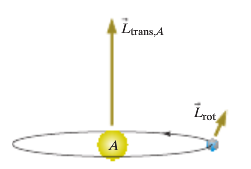
This image shows the translational angular momentum of the Earth (relative to the location of the Sun) and the rotational angular momentum (relative to the center of mass of the Earth).
It is also important to note that for point particle systems that there is no rotational angular momentum, and only translational angular momentum. This is important, because the total angular momentum for a point particle system is just simply translational angular momentum.
Understanding the topic of total angular momentum is extremely important in applying the conservation of angular momentum. Due to the fact that angular momentum is conserved, then it is important to note that if there is net force on some body directed towards a fix point, the center, then there is no torque on the body with respect to the center, and the angular momentum of the body about the center is constant. There is a very useful application of constant angular momentum, specifically seen in dealing with the orbits of planets and satellites. This concept is also used for the Bohr model of the atom.
History
Newton, in the Principia, hinted at angular momentum in his examples of the First Law of Motion,
"A top, whose parts by their cohesion are perpetually drawn aside from rectilinear motions, does not cease its rotation, otherwise than as it is retarded by the air. The greater bodies of the planets and comets, meeting with less resistance in more free spaces, preserve their motions both progressive and circular for a much longer time." However, his geometric proof of the Law of Areas is an outstanding example of Newton's genius, and indirectly proves angular momentum conservation in the case of a central force.
In 1736 Euler, like Newton, touched on some of the equations of angular momentum in his Mechanica without further developing them.
Bernoulli wrote in a 1744 letter of a "moment of rotational motion", possibly the first conception of angular momentum as we now understand it.
In 1799, Pierre-Simon Laplace first realized that a fixed plane was associated with rotation — his invariable plane.
Louis Poinsot in 1803 began representing rotations as a line segment perpendicular to the rotation, and elaborated on the "conservation of moments".
In 1852 Léon Foucault used a gyroscope in an experiment to display the Earth's rotation.
William J. M. Rankine's 1858 Manual of Applied Mechanics defined angular momentum in the modern sense for the first time:
"...a line whose length is proportional to the magnitude of the angular momentum, and whose direction is perpendicular to the plane of motion of the body and of the fixed point, and such, that when the motion of the body is viewed from the extremity of the line, the radius-vector of the body seems to have right-handed rotation."
See also
Further reading
Books and other print media that cover this topic in more depth:
Elementary Theory of Angular Momentum (Dover Books on Physics) by M.E. Rose
Matter and Interactions by Ruth W. Chabay and Bruce A. Sherwood
http://chaos.utexas.edu/wp-uploads/2012/03/Angular_Momentum_21.pdf
Video Content
Videos on Total Angular Momentum:
https://www.youtube.com/watch?v=8SfRmqSQENU&index=34&list=PL9HgJKLOnKxedh-yIp7FDzUTwZeTeoR-Y
https://www.youtube.com/watch?v=nFSMu3bxXVA
https://www.youtube.com/watch?v=diZDoY07LG4
https://www.youtube.com/watch?v=iWSu6U0Ujs8
External links
These are some internet articles that can show more animations and pictures to help understand this concept
http://www.phy.duke.edu/~lee/P53/sys.pdf
http://farside.ph.utexas.edu/teaching/301/lectures/node120.html
https://www.physics.purdue.edu/webapps/index.php/course_document/index/phys172/1332/135/9703
http://www.sparknotes.com/testprep/books/sat2/physics/chapter10section6.rhtml
http://hyperphysics.phy-astr.gsu.edu/hbase/amom.html
References
https://www.chegg.com/homework-help
http://www.sparknotes.com/physics/rotationalmotion/angularmomentum/section1.rhtml
http://www.phy.duke.edu/~lee/P53/sys.pdf
http://farside.ph.utexas.edu/teaching/301/lectures/node120.html
https://www.physics.purdue.edu/webapps/index.php/course_document/index/phys172/1332/135/9703
http://hyperphysics.phy-astr.gsu.edu/hbase/amom.html
http://www.sparknotes.com/testprep/books/sat2/physics/chapter10section6.rhtml
Professor Gumbart [Georgia Institute of Technology] Lecture Notes
Matter and Interactions 4th edition. Full Citation: Chabay, Ruth W., and Bruce A. Sherwood. Matter and Interactions. Hoboken, NJ: Wiley, 2011. Print.

